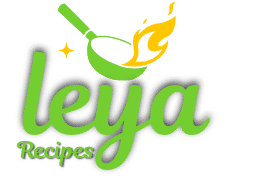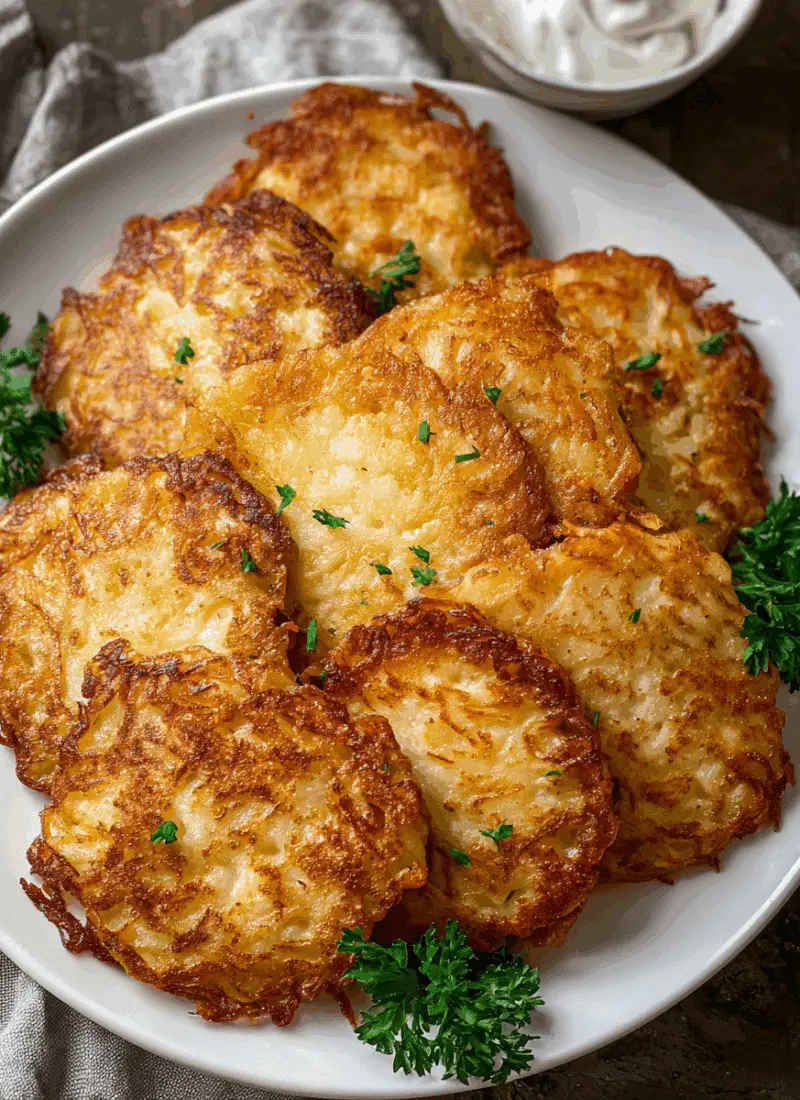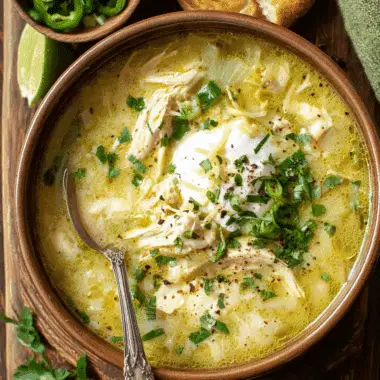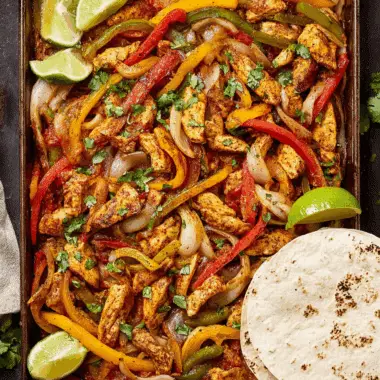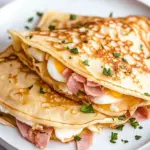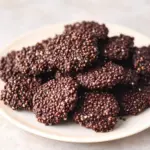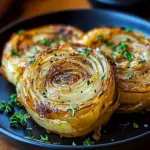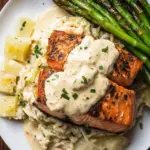These German Potato Pancakes, or “Kartoffelpuffer,” are a beloved classic in German households and street food markets. Made from simple pantry ingredients—grated potatoes, onions, eggs, and a touch of seasoning—these crispy golden discs are pan-fried to perfection and served traditionally with applesauce or sour cream.
Perfect for breakfast, brunch, or even a hearty snack, this dish brings both nostalgia and flavor to the table. Whether you’re recreating your Oma’s favorite recipe or trying Kartoffelpuffer for the first time, this is one recipe that delivers crisp satisfaction in every bite.
Full Recipe
Ingredients:
-
2 lbs (900g) starchy potatoes, peeled
-
1 small onion
-
2 large eggs
-
1/4 cup all-purpose flour
-
1/2 tsp salt
-
1/4 tsp black pepper
-
1/2 tsp nutmeg (optional)
-
Vegetable oil for frying
-
Applesauce or sour cream for serving
Directions:
-
Grate the potatoes and onion using a box grater or food processor.
-
Place the grated mixture into a clean kitchen towel and squeeze out as much moisture as possible.
-
Transfer the grated potatoes and onion to a large bowl.
-
Add the eggs, flour, salt, pepper, and nutmeg (if using), then mix thoroughly until a batter forms.
-
Heat a generous amount of vegetable oil in a large skillet over medium-high heat.
-
Spoon about 2 tablespoons of the batter into the skillet per pancake, flattening slightly with the back of the spoon.
-
Fry for 3-4 minutes on each side or until golden brown and crispy.
-
Remove the pancakes and drain on a paper towel-lined plate.
-
Serve hot with applesauce or sour cream.
Prep Time: 15 minutes | Cooking Time: 20 minutes | Total Time: 35 minutes
Kcal: 180 kcal | Servings: 4 servings
What Are German Potato Pancakes (Kartoffelpuffer)?
German Potato Pancakes, known locally as Kartoffelpuffer, are a beloved comfort food in Germany and other parts of Central Europe. These golden, crispy pancakes are made by combining grated raw potatoes with onions, eggs, flour, and seasoning, then pan-frying the mixture into deliciously crunchy cakes. They’re typically served with applesauce for a sweet contrast or sour cream for a tangy twist.
Kartoffelpuffer can be found everywhere in Germany—from family kitchens to street vendors at holiday markets. While they’re often associated with traditional German cuisine, variations of potato pancakes exist worldwide, including Swiss Rösti, Jewish latkes, and Polish placki ziemniaczane. What sets Kartoffelpuffer apart is their distinct texture and the cultural rituals surrounding their preparation and consumption.
A Deep Root in German Culinary Tradition
Kartoffelpuffer have been part of the German culinary landscape for centuries. Originally a peasant dish, they were created as a way to stretch basic ingredients—particularly potatoes—into filling meals. As potatoes became a staple in European diets after being introduced from the Americas, their versatility led to the invention of many iconic recipes, including these pancakes.
In Germany, these potato pancakes often appear at Christmas markets (Weihnachtsmärkte), served hot and fresh to festive crowds. Their popularity extends to all regions of Germany, though the name may vary: in Bavaria, they might be called “Reibekuchen,” and in other areas, “Grumbeerpannekuche.” Despite regional differences, the core concept remains the same—crispy on the outside, tender on the inside, and deeply satisfying.
Texture and Flavor Profile
The magic of German Potato Pancakes lies in their texture. When prepared correctly, they’re crisp and golden on the outside while remaining soft, slightly creamy, and flavorful inside. The shredded potatoes give the pancakes a light, fibrous bite, while the onion adds a savory depth.
Flavored with nothing more than salt, pepper, and sometimes a hint of nutmeg, the potato’s natural earthiness shines through. They’re typically fried in vegetable oil or clarified butter until perfectly crisp, making them a satisfying mix of crunch and richness.
When paired with applesauce, the result is a classic sweet-and-savory experience—a contrast that’s unexpectedly harmonious. Sour cream adds a creamy tang that cuts through the richness of the oil, offering a different yet equally traditional route.
Popular Serving Options
Though the classic toppings are applesauce and sour cream, modern variations and international influences have expanded how Kartoffelpuffer are served today. Here are a few popular ways they’re enjoyed:
-
Savory toppings: Smoked salmon, crème fraîche, chives, or even poached eggs for a brunch twist.
-
Sweet versions: Dust with powdered sugar and cinnamon if you prefer a dessert-style pancake.
-
With sides: Often accompanied by sauerkraut, bratwurst, or as part of a larger German meal.
-
Vegetarian options: A natural vegetarian dish, it can be adapted easily for plant-based diets with egg substitutes and gluten-free flour.
The dish’s versatility makes it ideal for breakfast, lunch, dinner, or as a party snack. Its simplicity allows home cooks to get creative without losing its authenticity.
Cultural Significance in Germany
In German culture, Kartoffelpuffer isn’t just food—it’s a symbol of family, nostalgia, and tradition. Many Germans recall helping their parents or grandparents grate potatoes as children, or the smell of pancakes frying during weekend brunches.
In regions like the Rhineland, Reibekuchen (a variation) is sold at weekly markets and carnivals. Families often have secret recipes or techniques handed down through generations—some prefer a finer grate, others a coarser shred for extra crunch. No matter the method, the dish is deeply personal and rooted in memory.
Kartoffelpuffer is also an important part of religious and seasonal festivals. During Advent, they are particularly popular in Christmas markets, offering warm, hearty food to shoppers braving the cold. Their simplicity and ability to feed many with few ingredients make them a practical and beloved food in both rural and urban settings.
Health Considerations
While Kartoffelpuffer is undeniably indulgent, it’s not without nutritional value. Potatoes are rich in vitamins C and B6, potassium, and dietary fiber. Eggs add protein, and if you use whole grain flour or add vegetables like carrots or zucchini, the pancakes become more nutrient-dense.
That said, the frying process does increase the calorie and fat content. For a healthier version, consider pan-frying in olive oil or air-frying. You can also bake them on a lightly greased tray for a lower-fat option. Using sweet potatoes or combining with root vegetables like parsnips and beets can also boost the dish’s nutritional profile while adding interesting flavor twists.
Why Kartoffelpuffer Remains a Global Favorite
Even beyond Germany, Kartoffelpuffer has found fans across the world. Its universal appeal comes down to three things: simplicity, comfort, and customization. With ingredients found in nearly every household, this dish is accessible to cooks of all levels. It’s also flexible—easily adapted to local tastes and ingredients.
In an era where food is both personal and cultural, Kartoffelpuffer bridges the gap between tradition and innovation. Whether you’re a purist who sticks to the original or a foodie looking to experiment, there’s room for creativity. Vegan? Gluten-free? High-protein? There’s a version for you.
Home cooks appreciate how quickly the pancakes come together—no fancy tools or hours of preparation required. For parents, it’s also a great dish to involve kids in the kitchen, offering a hands-on experience that’s both educational and fun.
Tips for Perfect Potato Pancakes
Achieving the perfect German Potato Pancake is an art. Here are a few expert tips to get it right every time:
-
Remove excess moisture: Grated potatoes hold a lot of water. Use a cheesecloth or clean towel to wring out as much liquid as possible. Too much moisture results in soggy pancakes.
-
Use starchy potatoes: Russet or Yukon Gold varieties give the best texture—crispy outside and tender inside.
-
Maintain medium-high heat: Too hot, and they’ll burn before cooking through. Too low, and they’ll absorb oil and become greasy.
-
Cook in batches: Don’t overcrowd the pan. This helps maintain heat and ensures even browning.
-
Serve immediately: These pancakes are best when fresh. If serving later, keep them warm in an oven on low heat to retain crispiness.
A Versatile Dish for Every Occasion
What makes Kartoffelpuffer so special is how well it fits into various meals and occasions. They can be elegant or rustic, light or hearty. Use them as a starter for a German-themed dinner party, a base for canapés, or even a brunch centerpiece.
In German households, they are sometimes eaten as a main dish, especially during Lent or on meatless Fridays. Add a bowl of soup or salad, and you have a wholesome meal. During Oktoberfest, they’re enjoyed as street food, hot and greasy from a paper plate, often chased by a cold beer.
You can even turn Kartoffelpuffer into a creative appetizer. Top them with goat cheese, herbs, or caramelized onions for a modern spin on a timeless favorite.
Conclusion
Kartoffelpuffer—German Potato Pancakes—are far more than just a side dish. They are a nostalgic, flavorful, and culturally rich food that continues to captivate hearts (and taste buds) across generations. Their crispy texture, savory taste, and versatility make them a staple worth exploring in any kitchen.
Whether you’re diving into German cuisine for the first time or reviving a family tradition, Kartoffelpuffer is the kind of recipe that brings comfort and joy to every table. Easy to make, satisfying to eat, and open to interpretation—this dish proves that sometimes the simplest recipes are the most enduring.
